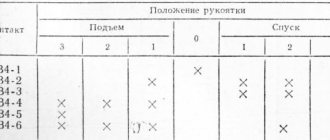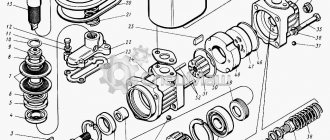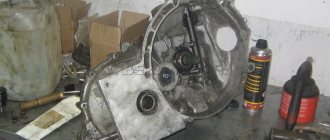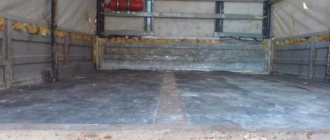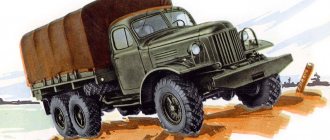All-wheel drive ZIS-32 1940
photo ZIS-32 all-wheel drive
ZIS-32
- serial
all-wheel
drive Soviet truck.
Production began in 1940 at the Stalin Automobile Plant. The prototype of the ZiS-32 was the NATI-K2 (NATI-ZIS-K2), developed and tested in 1939 at the Scientific Automotive and Tractor Institute and was a modification of the serial rear-wheel drive three-axle truck ZiS-6, redesigned for all-wheel drive. Despite the fact that, in fact, at the end of winter 1939, the NATI-2K was put into service as an all-wheel drive truck for the army, quite a lot of problems lay ahead. The biggest dependence was on another automobile plant, GAZ, which produced some of the ZiS-32 components, in particular, the main gear. It was not possible to produce the same unit on the ZiS, and according to the technical standards of that time it was impossible to install the final drive from the GAZ-AA on the ZiS-5 axle on a production car. As a result, it was necessary to install on the front axle
of the ZiS-32 the main gear from the ZiS-5, which was originally intended for the rear, loaded axle and therefore weighed more than the lightweight “front” one from the GAZ-AA. And this, as you understand, increased the weight of the car, and this weight was useless - tens of kilograms of iron.
photo ZIS-32 all-wheel drive
Power 73 hp. s., which the ZiS-32 retained from experimental models, was clearly insufficient. But this was not the only thing that slowed down the acceptance: the ZiS-32 did not have tow hooks, and yet a military truck was required to have them. There were a few other “parts” missing, too, but the most difficult one was the lack of power. In 1940, a forced ZiS-16 engine
, but their quantity was not enough to equip all ZiSs, and it was impossible to quickly increase their production capacity.
Meanwhile, the Great Patriotic War was approaching, and the war with Finland was already underway. In the fall of 1940, two intermediate models ZiS-32R and ZiS-32S were created and tested (the first with Rtseppa CV joints, and the second with Spicer CV joints and a raised platform). The commissions recognized that the experimental ZiS-32R and half-track transporter ZiS-22-52 (a modified ZiS-22, which by that time had already been produced in the amount of 200 units) were suitable for serial production. It was decided to start mass production in 1941, but the plant did not have enough production capacity for this, since they were occupied by the serial ZiS-22 and ZiS-33
. The main problem was the lack of equipment for the production of Rtseppa type CV joints. Under the pressure of all these circumstances, production of the ZiS-32 was postponed until the end of the Finnish War, then it was resumed, and at an accelerated pace. As the builds progressed, problems constantly arose and various shortcomings had to be eliminated. To increase production, bonuses were paid to the staff for each machine assembled. But at the end of July, the war began, and the plant received military orders - there was no time to modify the car. Therefore, the 197 ZiS-32 trucks produced were sent to the front, and production was closed. In mid-October, the evacuation of the plant began - Hitler’s troops were steadily approaching Moscow.
photo ZIS-32 all-wheel drive
From the article by Alexander Kirindas “ZiS-32: Together with tanks” December 3, 2022 on zen.yandex.ru. Deep gratitude to the author.
Mid 1930s. In the Soviet Union, all-wheel drive vehicles were still considered exotic. And in industrialized countries, similar equipment of various types and sizes was mass-produced. Urgent measures were required to establish production of domestic army all-terrain trucks.
Postulate of the art of war: the success of combat operations directly depends on the mobility of troops, and their combat effectiveness - on the state of transport and communications. Off-road conditions can cause serious damage: rifle and artillery units get stuck in impassable mud, tank formations are deprived of the supply of ammunition and fuel...
When the first cars were tested by the army, the designers were already closely working on the problems of increasing cross-country ability. Almost immediately, three main directions of work on military all-terrain chassis were outlined: half-track (front wheels - on a regular front axle, instead of a rear axle - tracked), three-axle (two driven rear axles with a non-driven front axle) and all-wheel drive.
In 1912, the French and “Balakhovsky-Car” (the inventor of the electric transmission D.M. Balakhovsky lived in France) mastered the production of the first functional cars with “four active wheels” (as four-wheel drive was called at the beginning of the 20th century). Also in 1912, all-wheel drive Panhard trucks began to enter service with the French army; they were used as artillery tractors.
A year later, trucks from the above-mentioned manufacturers reached Russia, two samples were presented at the IV International Automobile Exhibition in St. Petersburg. After the capital's auto show, all-terrain vehicles were tested in the Russian open spaces - on and off-road. The cars performed quite well.
Almost simultaneously with rear-wheel drive three-axle cars (1923), the world's first all-wheel drive three-axle cars appeared in France, but their design was imperfect. From a military point of view, three drive axles were preferable, but due to the design complexity and labor-intensive operation at that time, representatives of the 6x6 formula were unable to gain popularity.
One of the factors hindering the advancement of all-wheel drive vehicles into the commercial market was overcome - the production of efficient synchronous constant velocity joints (CV joints) was established. The first all-wheel drive vehicles used asynchronous universal joints, which caused significant uneven rotation, which led to increased operating loads in transmission units, their increased wear and breakdowns.
By the period under review, CV joints, identified by domestic experts as “Bendix-Weiss”, “Trakta”, “Rtseppa” and “Spicer”, had gained recognition abroad. These devices have their advantages - they are reliable and easy to use. The disadvantages were expressed in the high degree of complexity and labor intensity of production.
The companies that produced CV joints willingly sold them to the Soviet Union, but were in no hurry to share technical secrets - it is very difficult to master the licensed production of joints on your own. However, the problem was resolved.
Be that as it may, by the end of the decade there was a firm belief that it would organize its own production of CV joints suitable for installation on three-ton trucks. The prototypes could be the Rtseppa or Spicer products. At the same time, the first information about promising developments in the domestic automotive industry leaked to the industry press.
Specific figures, technical data and characteristics were not published due to secrecy - the main customer was the People's Commissariat of Defense. On the instructions of the People's Commissariat, a purely experimental two-axle all-wheel drive vehicle NATI K-2 (in the documents - ZiS-NATI K-2, simply K2) was built at the NATI pilot plant.
The prototype was tested and refined for a long time - one after another, numerous flaws were discovered and corrected. But finally, the developers were able to report to management about the results of their work, outlining the product as follows:
“The K2 with both drive axles is based on the ZiS-6. The bogie was replaced by one ZiS-6 worm drive axle with a ZiS-5 rear spring suspension and the front axle was replaced with a special drive axle with partial use of parts from the GAZ-AA axle.
The installed dismountable box uses parts of the ZiS-6 range multiplier. The brake system retains the ZiS-6 Devander type vacuum servo device. Central handbrake ZiS-6 disc type.
Other units.
- The front drive axle has a gear ratio of 6.6. Removable axle shafts: Rzepp cardan shafts, nominal size 1/4”. Wheel rotation angle is 28°. Transmission of pushing force and reactive torque by springs.
- Collapsible box. Combines the functions of a range multiplier (with a gear ratio of 1.53) and a power take-off to the front axle. Allows you to have the following options:
1) only the rear axle is engaged in direct transmission,
2) only the rear axle is engaged in downshift,
3) the rear and front axles are engaged in downshift,
4) neutral position.
- The drive to the front axle is carried out by a cardan shaft with GAZ-AA Cleveland-type cardan joints.”
The maximum speed was specified as 58.5 km/h, and the climbability was 30°.
The state leadership trusted such a cheerful message; on December 19, 1939, the Council of People's Commissars of the USSR issued Resolution No. 443, according to which the ZiS-32 truck with all-wheel drive was adopted.
At ZiS, a project for a promising car was drawn up and sent to the customer for approval. The military did not like the lack of front tow hooks and a rifle mount in the cockpit, and many other little things. The power of the ZiS-5 engine was low (73 hp). Meanwhile, the People's Commissariat approved the following work plan for the ZiS-32:
“Release of temporary drawings 15 March 40.”
Production of 2 experimental samples on May 15, 1940.
Development of technology, issuance of orders for tools June 1, 1940.
Release of working drawings June 15, 40
Clarification of technology and issuance of orders for equipment on June 25, 1940.
Production of reference samples September 1, 1940
Serial production began on October 1, 1940.
Production: In October 5 pcs. In November 10 pcs. 25 pieces in December.”
The annual production volume was supposed to be 4,000 copies.
Development of the series required the acquisition of new equipment and the use of production space of 2500 m2. There were no such ones at the plant, and the existing ones were occupied by ZiS-22 and ZiS-33. Therefore, until the task of the party and government to produce the ZiS-33 was completed and the production of the ZiS-22 was stopped, or the construction of new buildings and the reconstruction of the old ones, it was not possible to establish the production of the ZiS-32.
In addition, the most important unit of an all-wheel drive truck - the front axle - had not yet been worked out, since there was no clarity on the question: with which CV joint the vehicle would have to go into production. Therefore, the schedule cited above was never implemented. Until the end of the Finnish campaign, work on the ZiS-32 was practically not carried out at the plant.
Meanwhile, the party, economic and industry leadership discussed the progress of the implementation of the ZiS-32. A series of meetings were held at the highest level, as a result of which a draft government decree was prepared “On the production of tanks, artillery tractors, chassis for armored vehicles and vehicles with two driving axles.”
The need was emphasized to “oblige the NKSM to create, by April 1, 1941, production capacity” for GAZ-61 - 10,000 units per year, and ZiS-32 - 4,000 units per year. It was planned to introduce all-wheel drive semi-trucks into mass production, both in two- and three-axle versions.
As you can see, the original deadline was canceled and the release start date moved to next year. The draft resolution (25 secret sheets in total) was distributed to the authorities. The results of the discussion began to be summed up only in the second half of the summer. After considering the comments, the top officials decided to vote, and therefore an explanation was sent to Marshal Voroshilov:
“The draft Resolution was voted on by everyone, with the exception of Comrade Comrade. Stalin I.V. and Molotova V.M. Further voting on this project was suspended, since during the voting process an instruction was given to increase the production of the KV and T-34 tanks in 1940... The deadlines for creating capacities for St-2, STZ-5 [both designs are artillery tractors - author's note], GAZ-61, ZiS-32 and ZiS-bK [chassis for the promising BA-11 armored car, which in the series was called ZiS-34 - author's note], since the industry is not able to highlight all equipment and part of the equipment will be allocated in the first quarter of 1941.”
Of course, the type of equipment for the production of tanks and CV joints was not identical, the funds for its acquisition were simply limited. After all, a significant part of the machines was still supposed to be purchased for foreign currency or manufactured in single copies at domestic specialized enterprises, which then had limited production capacity.
As a result, on July 26, a resolution was adopted obliging the creation of capacity for the production of ZiS-32 - 2000 per year by August 1, 1941. In other words, by the end of 1941, a little more than 800 vehicles were to be built, and the next 2,000 units were to be delivered by the plant in 1942.
As a result, the ZiS-32 prototypes arrived for testing only in the fall of 1940. Moreover, the military did not plan to abandon the ZiS-33, built in a batch of 4,500 units, and the ZiS-22, restored on the assembly line (additional plan - 250 copies). Therefore, in the Moscow region, from September 3 to September 30, 1940, large-scale tests of all-terrain vehicles were carried out with the involvement of specialists from NATI, GAZ and ZiS, and from interested departments.
We tested all-terrain vehicles GAZ, K2, various variants of ZiS-22 and ZiS-ZZ, as well as all-wheel drive ZiS-32R and ZiS-32S. The ZiS-32R had “Rtseppa” CV joints, and the ZiS-32S had a “Spicer” type. On the route over particularly difficult off-road conditions, only one of the experimental versions of the ZiS-22 did not have serious breakdowns. The test results were approved on December 29, 1940.
The conclusions noted that of all the presented vehicles, only one of the new variants of the ZiS-22 with a forced engagement mechanism and the “two-axle ZiS-32R vehicle with all-wheel drive, designed by the Plant named after. t. Stalin, as a three-ton off-road truck (in comparison with the ZiS-5), which can be used as a normal transport vehicle with a trailer; in the future should replace the ZiS-5.”
The conclusion was as follows:
“Based on the test results, we recommend the following brands of cars for further refinement and acceptance for supply to the Red Army:
- Half-track vehicle ZiS-22-52.
- Wheeled vehicle with all-wheel drive ZiS-32R.
The specified brands of cars will be processed in accordance with the general conclusions and instructions of this report for each car and industrial samples will be produced for field tests for warranty kilometers and the determination of operational standards.”
Thus, the type of all-wheel drive vehicle was fundamentally worked out, and now it was already possible to begin preparing for production. To avoid confusion, the letter “P” was removed from the marking.
Now you can theorize as much as you like on the topic: “What would happen if…”. But history, alas, does not tolerate the subjunctive mood. Before the war, they did not manage to master the mass production of the ZiS-32, and this was not envisaged in 1941. But those same month and a half turned out to be decisive. Then urgent front-line orders came and the evacuation began.
The all-wheel drive topic of the ZiS was closed for an indefinite period of time. One of the prototype cars was still preserved at the manufacturing plant, but was subsequently scrapped. Before the start of deliveries under Lend-Lease, there were almost no all-terrain vehicles with all-wheel drive in the army.
Only 197 serial ZiS-32s were produced. The vehicles were transferred partly to air bases of the Moscow Military District, partly to the 2nd Shock Army. In the 2nd UDA, all-wheel drive trucks, along with half-tracked vehicles assembled from other formations, were supposed to provide transportation in the particularly difficult snowy off-road conditions of the winter of 1941/1942.
The task of the 2nd Shock was to break the blockade of Leningrad. The tragic fate of the blocked and surrounded army is well known. The soldiers and commanders loyal to the commander, General Vlasov, continued to fight until July 1942. In order to avoid capture by the enemy, the equipment in the army was destroyed, mainly by blowing up...
Many years of search work and archival research helped to discover in the area where the 2nd Shock Army died, fragments of the GAZ-60 half-track and other vehicles. Now they are preserved in the National Automobile Museum in Vsevolozhsk in the Leningrad Region. During the search, a badly destroyed ZiS-32 was also found (there are apparently no complete copies of this brand now). And for several years now, attempts have been made to remove what is left of the car. Heavy off-road conditions interfere.
Engine ZIS-32
At the Ulyanovsk Automobile Plant (at that time UlZiS - a partially evacuated Moscow ZiS, now UAZ) another unusual ZiS-32 was created. Already during the evacuation, the plant was working on the ZiS-253 vehicle. And its prototype was created on the basis of one of the ZiS-32s evacuated from Moscow (several vehicles were in a convoy as ordinary trucks - they transported equipment and people during the evacuation). The ZiS-32 was equipped with an American 3-cylinder diesel engine GMC-3-71
, which they wanted to use for the ZiS-253. The torque of the diesel engine was 10% higher than that of the ZiS-5 engine (it was supposed to be used earlier), and because of this, there was no other “candidate” than the ZiS-32 at the plant. The diesel engine was not only “stronger”, but also much larger than the small 73-horsepower ZiS-5 engine, so a long cab from a Chevrolet G7107 truck was installed on the prototype, after which the ZiS-32 looked completely different. After the war, this car (it was not assigned an index), together with the ZiS-253, which had already been created but did not go into production, made a run from Moscow to Ulyanovsk, and that’s all that is known about this car. Most of the ZiS-32s were lost during the war - some during battles, some were blown up in the winter of 1942 during the encirclement of the notorious 2nd Shock Army (a few trucks ended up there by distribution). The remaining cars were used mainly in the army and at the car plant itself. None of the trucks have survived to this day; at least, I did not find any information about it.
GAZ or Willys?
Compared to the American Willys SUV, the Soviet car was 300 kg heavier, less powerful (the Willys engine developed 60 hp) and less dynamic (the maximum speed of the GAZ-67B was 88 km/h, the Willys was 104 km/h). The braking dynamics of the American car with hydraulic brakes was, of course, much better than that of the GAZ-67B with its mechanical brake drive. The braking distance of the Willis from 50 km/h was 9.5 m, and that of the GAZ-67B was 16.5 m!
Serial GAZ‑67 already has a wide track.
Serial GAZ‑67 already has a wide track.
